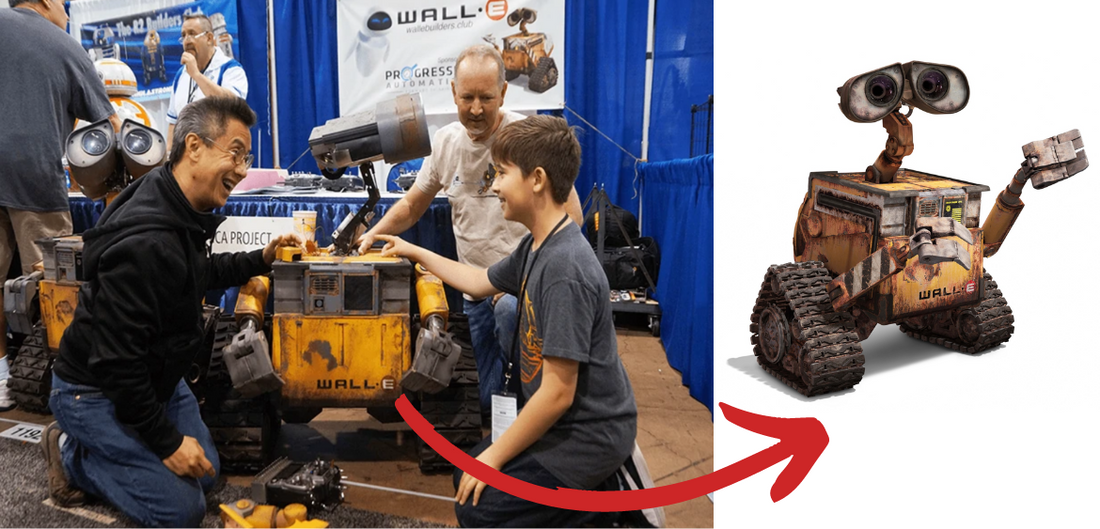We’re taking a look back at some of our most popular articles, revamping them and republishing them to be enjoyed again! Back in 2019 Progressive Automations met with Mike Senna and Michael McMaster to discuss all-thing’s robots!
Everyday, there is always something that we may find fascination from in life. Comic books, Disney movies, pop culture and cosplay are a few examples of what brings joy, imagination, and creativity to many. Events such as WonderCon 2019 held at the Anaheim convention center are perfect for those of us who have a passion for this genre. The little sibling of Comicon was very well received, and we had the opportunity to support the real-life Wall-E builders once again.
Soon after the show, we had a chance to catch up with Mike Senna and Michael McMaster, the robotic builders with an interest in all thing’s robots and Star Wars. Senna and McMaster met in 2003 at the R2 Builders Club. “We met through the club, and we immediately hit it off as we have the same creative minds. I joined this club in 2002 with the hope of building my favorite character from Star Wars,” said Senna. After completing the R2 Robot, this led Senna to contract an opportunity to work with Lucasfilm and has been on for the last 14 years!
The Wall-E Builders Club
The Wall-E builders club was later conceptualized before the popular Disney movie had been released. Michael McMaster said, “In October 2007, Scot Washburn formed the Wall-E Builders Club. All the team had at that time, were a handful of still images, a B&L website and a movie trailer for reference.”
Senna joined the Wall-E club in 2010 and on seeing there were no working Wall-E models built, he invited McMaster to join the team. Senna worked out the body, arms, and head dimensions while McMaster worked on the drive train. “Both tasks were very intense and after 2.5 years of development we had the first working model of Wall-E!,” explains Senna.
Bringing Wall-E to Life with Actuators

As there weren’t any hobbyist shelf parts or mechanisms available, everything was hand fabricated from scratch. “We did a lot of research before building, including collecting every image we could get our hands on of Wall-E. As it was an animated character, it so often broke the laws of physics (and sometimes even physical space limitations), which we had to work around!” said, McMaster.
To replicate the appearance of a real Wall-E robot, Senna used electric linear actuators to move Wall-E’s head up and down, “Wall-E was the first project I used Progressive Automations actuators to not only move the head but also to raise its arms.” The actuators used were the PA-14-1-50 to move the head and PA-14-2-150 for moving the arm.
The new and improved PA-01 mini actuator (PA-14 upgrade) is the current model we offer with a variety of added benefits. For a comparison, check out the tables below and upgrade with confidence!
|
|
PA-01 |
PA-14 |
|
Dynamic Load Options |
16, 28, 56, 112, 169, 225 lbs |
35, 50, 75, 110, 150 lbs |
|
Highest Load |
225 lbs |
150 lbs |
|
Fastest Speed |
3.54 "/sec |
2.00"/sec |
|
Ingress Protection |
IP65 |
IP54 |
|
Stroke Options |
1" to 40" |
1" to 40" |
|
Hall Effect Feedback |
Optional |
No |
Wall-E Arm and Head Movement Demo using Progressive Automations Linear Actuators:
Senna explains how our actuators can create the required motion on Wall-E in real life, “I control the head with a standard speed controller that is plugged into the remote-control receiver for moving with the transmitter sticks. The arm actuator is run by a PIC chip that I programmed to perform certain automated actions with a press of a button the robot actuator raises the arm and the arm waves, the arm stops waving, then lowers back down.”
The remote controlled Wall-E also utilizes a Shutoff Safety Switch as demonstrated in the video below:
McMaster and Senna also discussed the use of Progressive Automations actuators, “We required actuators that were durable, reliable and easy to configure to our application. We chose Progressive Automations because of the large range of force and stroke options available. The actuators have been used for over 7 years since we bought them, and we have never had a single issue or failure. These are tough actuators!”
BB-8, R2-D2, & Wall-E at WonderCon 2018
We were also privileged to meet and sponsor McMaster and Senna at the 2018 WonderCon! They were able to build these robots with the help of our linear actuators, and even hosted their own workshop at WonderCon 2018 to discuss how exactly they built their amazing robots in Room 210. Check out the video of WonderCon 2018 below.
Wall-E at WonderCon 2019

If you’ve watched the movie, one can easily connect with the Wall-E character. His unique and friendly manner has an effect on everyone he meets in not just the science fiction film but also in reality at the Anaheim WonderCon show. “We have had some incredibly positive reactions. A handful had become so emotional that they cried tears of joy when they interacted with Wall-E! Small children love this big-eyed, big heart robot and while they’re hesitant at first, usually warm up after a brief interaction,” explains McMaster.

What’s Next?
Both McMaster and Senna are working on multiple other projects, most of them being new robot designs. However, they do hope to add more functionality to their real life Wall-E as time allows. “With the publicity, Wall-E has received recently; the club has become very active. There are multiple builds taking place, and many new developments such as 3D printing, which brings a whole new level of construction techniques to the club.”
For more upcoming projects, feel free to follow Mike Senna and Michael McMaster on Youtube!
Check out our webinar with guest speaker Mike Senna!:
In Summary
McMaster and Senna have been innovators for many years and know what it takes to make it in the industry. Their advice to aspiring DIY creators and innovators –
“Never give up! Look around you and be persistent about finding out how things work. Whatever you build, give it your best! If you fail, push yourself to try again. Never forget that failure is also part of the learning process.”
Thank you to McMaster and Senna for sharing your real-life Wall-E project!
If you have any custom projects, applications, or technical questions on our products, feel free to reach out to us at sales@progressiveautomations.com or call 1-800-676-6123. We look forward to hearing from you!




